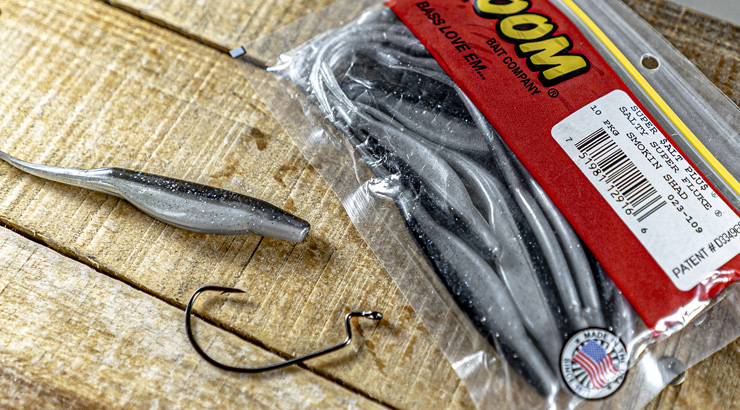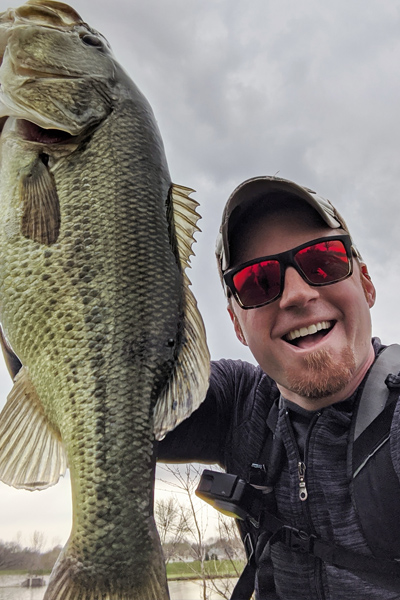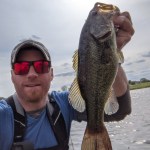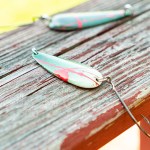“Son of a… another snag?!“
It’s March in the Midwest. Water temps have barely hit the 50° mark on the surface. In fact, just two weeks ago most of the small farm ponds that line the interstate were still sporting a layer of crusty, frozen slush.
Things are changing.
“Dang it…“, you grumble as you waste time picking the cold, messy wad of brown snot off of your exposed swimbait hook for the 563rd cast in a row. “It’s cold. I want to fish a jerkbait but can’t because of all the floating dead debris from last year. Those trebles don’t stay clean for a single twitch. How about slowly working a shaky head? Can’t. As soon as that weight lands in the muck on the bottom, it gets sludged up even if my hook doesn’t touch it… it’s too windy for a weightless Texas Rig, and don’t even think about dragging a jig… what the heck am I going to do?“
You violently shake your rod tip in an attempt to both relieve your frustration and dislodge the remaining mucky morsels from your lure, debating whether or not to make a long cast and let it sink, then work it back slowly – like you should – or make a short little pitch simply so you don’t have such a mess to clean off when you get it back to shore.
It’s a lose-lose proposition.
Your fingers are now cracked and bleeding in a few new spots. That’s what happens when you get them wet again and again and again in cold, windy weather. It’s tolerable when you’re catching fish, but today…
“This is not working… so now what!?”
Time to get creative.

The Origin of The F4 Rig
The F4 Rig (meant for Flexible Finesse Fluke Fishing) was something that I created out of necessity. During a particularly mild day in very late winter, my son noticed a small silver shiner with traces of light purple & blue coloring while we were walking around the lake. Just a few weeks earlier, this same lake had ice on it.
We’re not sure why or how this shiner ended up on the shore, but it told us something; the local forage is not limited to bluegill, crappie or even bullhead. These little 3.5″ silver shiners dart around the shallows, and there is a good chance that they are both the appetizers and the main course for bass of every size swimming in the lake.

As the water continues to warm, bass will move up onto the large shallow food-shelf areas filled with these small, frantic baitfish. They’ll start to feed, and we need to present a small bait efficiently, but also cover a fair amount of water. So the question is this: how can we imitate the forage convincingly in a way that allows us to fish multiple depths, at multiple speeds with the least amount of mucky snags?
First: Select The Bait

The Z-Man StreakZ in 3.75″ is a perfect little pot-bellied shiner imitation in terms of both size and color (try “smokey shad” or “the deal” for a silver or blue tint). I’ve also had a lot of luck using green pumpkin in this lake, so my follow up of choice is The Standard Zoom Fluke in a two-tone “baby bass” color that has a bit more fleck and sparkle.
It’s a bit more… fabulous…
*shudder*

It’s also smaller than the extremely popular Zoom Super Fluke.
We’ve caught some great fish on this larger offering (as seen on Thursday Night Fishing) and later in the year the Super Fluke will definitely be paired with The F4 Rig, and a larger hook. It will come into play around rip-rap to mimic spawning or feeding baitfish, while helping us avoid some of the snags that come with using heavy, compact weights (jigs, shaky heads) around jagged rocks.

Another reason we’re going to experiment with a green color is because we definitely know that bass eat other bass… or… they try to eat each other… it doesn’t always work out too well… we found the proof of that last time, right after we found that silver shiner!

Also, it’s important to note that in this body of water largemouth bass are the primary, dominant predator. We have no walleye, pike, or muskie. This means we won’t get bit off, and the bass can (and do) use any depth and any location they want in the lake.
Having the flexibility to fish shallow or deep, fast or slow, calm or erratic is critical for maximizing our limited time on the water.
Next: The Complete F4 Delivery System
The F4 delivery system is incredibly simple. Dare I say… minimalist?

The Rod: 7′ Medium Heavy Spinning (The BBFF from our Rod Repair Video)
The Reel: Shimano Solstace 2500 (Alternative: Shimano Syncopate)
The Line: Berkley Vanish Fluorocarbon 8-Pound Test
The (Single) Knot: Palomar
The Weight: 1/16 ounce bullet weight
The Clack: 2 rubber bobber stops + 1 plastic bead
The Hook: 2/0 Trokar Pro-V Worm Hook or a Trokar EWG
ASSEMBLY: Grab your spinning rod, reel, and spool up with 8 pound test fluorocarbon. Fluoro will sink (helping your bait get deeper, faster) and give you greater sensitivity and power on the hookset compared to mono. It offers the most abrasion resistance around rocks, and is much less visible than braid. Low visibility is key, because we need the option of stealth. Attach the components (in this order) to your line:
Bobber Stop #1 | 1/16 Ounce Bullet Weight | Plastic Bead | Bobber Stop #2 | 2/0 Worm Hook w/ Palomar Knot
Add your favorite soft plastic. Fish. Enjoy. Repeat. Tell your friends. Or maybe don’t.
Any plastic will work – but The F4 Rig was originally designed for smooth, snagless fluke fishing.

Keep reading – there are several nuances to keep in mind and countless ways to fine-tune this rig so you can maximize your time on the water!
It’s like a Texas Rig… but it isn’t…

The original concept was to create a “finesse Texas rig” for fishing around all of the muck in my lake after a frustrating afternoon fishing with exposed hooks. I wanted the weight to move freely up and down the line – however – also needed to be able to “peg” the weight close to the bait if too much muck was getting picked up. The bobber stops give me the best of both worlds – allowing the weight to be pegged close to the bait, pegged away from the bait and further up the line, allowed to float freely, OR float within a dedicated range higher up the line, never coming into contact with the bait. This last option allows me to let the weight sink and land on the mucky bottom, but floating plastics stay slightly suspended and right in the face of curious bass – which is incredibly effective.
Never use toothpicks to peg your weight when you are using light line. You will compromise your rig.
It’s like a Carolina Rig… but it isn’t…

The Carolina Rig requires 3 knots and several additional components (weight, bead, clacker, swivel, leader, hook, bait… and again, 3 knots). They utilize a heavier weight and typically include a brass “clacker” somewhere between the weight, the bead and the swivel. Dragging a Carolina Rig on the bottom kicks up sediment and causes a disruption – it is suited for rocks & gravel, not mucky bottom.
The plastic bead between the weight and the lower bobber stop on The F4 Rig will give off a slight “click” if you need noise as an extra attractant (like in murky water or on windy days), but it is more finesse than that big ‘ol Carolina clack.
It’s like a Tandem Fluke (Donkey) Rig… but it isn’t…

Want to move faster to trigger bites? No problem. Twitch The F4 Rig along the surface to create the illusion of a baitfish chasing something small and edible as the weight and fluke bounce back and forth with every snap of the rod tip – similar to the triggering effect of a tandem fluke rig (aka the Donkey Rig or Double Fluke Rig).
It’s like a Split-Shot Rig… but it isn’t…

Split-Shot Rigs are a great option around rip-rap or when you’re targeting finicky bass. They are not a great option around muck and weeds – it is incredible how much muck and debris the jagged, pointy edges of the traditional easy-pinch removable sinkers will pick up on a single cast. And slipping through the suspended debris without getting hung up?
Not gonna happen.
The bullet weight on The F4 Rig is much more streamlined, allowing the angler to make repeated muck-free retrieves.
It’s like a Mojo Rig… but it isn’t…

The Mojo Rig is similar; a hybrid rig between the Split-Shot Rig and a Carolina Rig. Mojo Rigs utilize a cylindrical weight and a single rubber stop between that and the hook. They are silent. By using a bullet weight and a bead, we can create space on The F4 Rig to add subtle noise when needed, push the stoppers together for complete stealth, or push our bobber stops down to the hook to fish a traditional Texas Rig with the weight pegged or free-floating.
A super-fast modification that takes seconds without requiring any retying – complete with bullet weight.
This gives you extreme versatility.

Give The F4 Rig A Shot!
The F4 Rig was born out of necessity. It stays weedless. It creates noise. It can be silent. If you’re using a floating plastic it stays off the bottom. It’s flexible. It allows you to experiment with different leader lengths (from several feet to zero inches) without retying. It’s subtle. It’s erratic.

It’s a Flexible Finesse Fluke Fishing delivery system, and it will put more bass in your boat.


Let me know how it works for you.
Tight lines!

NEXT SECTION: Catch & Release Fishing
PREVIOUS SECTION: Location of Largemouth Bass by Region







































9 Responses
[…] SECTION: Learn to Fish The F4 RigPREVIOUS SECTION: A Brief History of […]
[…] PREVIOUS SECTION: The F4 Rig: Flexible Finesse Fluke Fishing […]
[…] PRESENTATIONS:Power Rig: Baitcaster w/ Killer Little SwimbaitFinesse Rig: Spinning w/ F4 Rigged Zoom Fluke […]
[…] bait wacky style, on a Carolina rig, suspend it below a float for smallmouth bass or put it on an F4 Rig… the options are […]
[…] my bag for this reason – but don’t be afraid to try these stickbaits on a Texas rig, an F4 Rig – even below a Pop ‘n […]
[…] I was able to call an audible after 30 minutes of unproductive fishing. My F4 Rig was getting snagged up on all the creek bed debris, but my Pop ‘n Drop rig allowed me to make […]
[…] we have the F4 Rig, which is super-versatile and allows you to quickly switch between a Carolina, Texas, or in-between […]
[…] this video, I’ll explain a bit more about The F4 Rig, which was originally developed to help fish flukes through heavy cover. Here’s how you rig […]
[…] Z-Man Hula Stick on an F4 Rig […]